Have you ever wondered if keeping your teeth clean is simpler with braces or clear aligners? You’re not alone! With so many people choosing between traditional metal braces and the newer clear aligners, one burning question always comes up: When it comes to daily maintenance & hygiene, which is easier—braces or aligners? Keeping your smile healthy should never feel confusing or overwhelming. This comprehensive, easy-to-read guide unpacks everything you need to know, helping you make the best decision for your smile, lifestyle, and oral health.

Curious About Maintenance & Hygiene: Which Is Easier, Braces or Aligners? Let’s Unpack the Facts
Deciding between braces and aligners isn’t just about looks—it’s about daily life. Maintenance & hygiene: which is easier, braces or aligners? The answer can depend on your habits, routine, and what feels comfortable to you. Braces are fixed to your teeth (like classic metal braces or ceramic options), using a system of brackets and wires. That means cleaning needs extra care around those parts. On the other hand, clear aligners are removable trays you slip on and off. If you dread the thought of food stuck in wires or the challenge of brushing around brackets, aligners might seem like an easier choice. Yet, understanding each process step-by-step is essential for true clarity—so you can keep your teeth and gums at their healthiest, no matter your pick.
Most people want a maintenance routine that fits easily into busy lives. That’s why this guide dives deep into real-life cleaning routines, product tips, and expert insights on oral hygiene during orthodontic treatment. Whether you’re considering highly effective metal braces or the flexibility of virtually invisible clear aligners, you’ll get practical advice and proven strategies for a straighter smile—with as little hassle as possible.
Opening Hook: Have You Ever Wondered If Braces or Clear Aligners Are Less Hassle to Clean?
Imagine rushing to school or work and realizing you need to clean your teeth—but you have a mouth full of brackets, wires, or removable trays. Which treatment makes oral hygiene easier? In this guide, we’ll look at daily cleaning routines and break down the facts so you can confidently choose the path that keeps your smile healthy with less stress.
What You’ll Learn in This Guide on Maintenance & Hygiene: Which Is Easier, Braces or Aligners?
- How maintenance and oral hygiene routines differ between clear aligners and traditional braces
- Practical tips for keeping both types clean
- Insider insights into common challenges and how to solve them
- Which option fits best for lifestyle, efficiency, and comfort
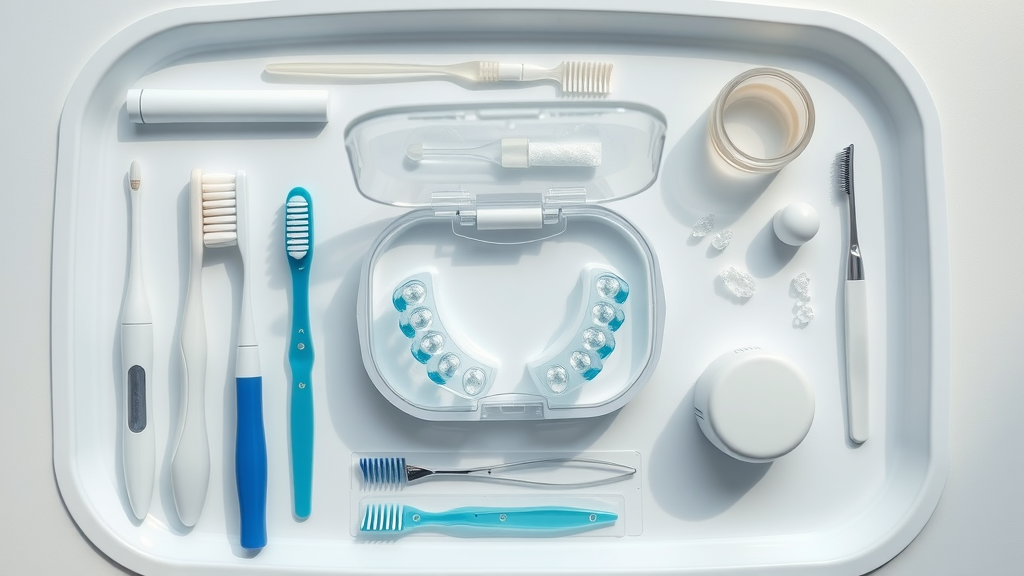
Understanding Orthodontic Treatment: Clear Aligners vs. Traditional Braces
To truly answer the big question—maintenance & hygiene: which is easier, braces or aligners?—we need to start by understanding what each treatment involves. Traditional braces use metal or ceramic brackets bonded to your teeth. Wires and rubber bands guide teeth movement over time. These are highly effective for simple to complex orthodontic issues, but their fixed nature makes cleaning a frequent challenge, especially around metal brackets. Clear aligners, like Invisalign, are custom-made plastic trays that fit snugly over your teeth and can be removed during eating or cleaning. They work best for mild to moderate cases and are virtually invisible—appealing features for many teens and adults.
While both straightening systems aim for a straighter smile, their daily routines and impact on oral hygiene are very different. Aligners win in terms of flexibility and removability, as you can take them out before meals and clean teeth without obstruction. Braces, however, are fixed—so you’ll need to follow special oral hygiene steps daily. The bottom line is that your choice between braces and aligners doesn’t just impact how you look, but how you care for your teeth every single day.
Key Differences Between Clear Aligner, Clear Aligners, and Traditional Braces
- Appearance
- Daily routines
- Flexibility and removability
- Impact on oral hygiene
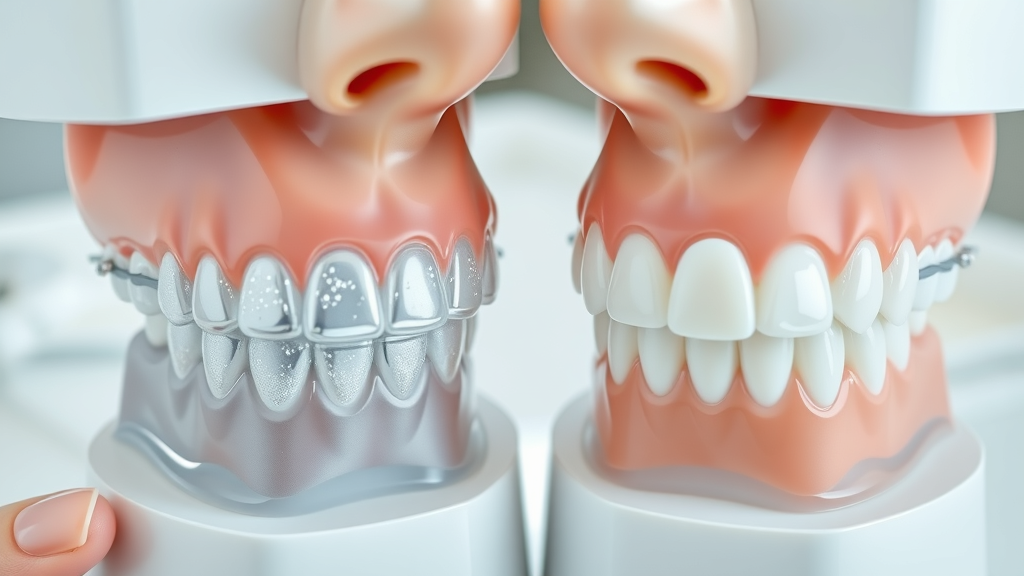
Why Maintenance & Hygiene Matters During Orthodontic Treatment
Maintaining your oral hygiene during orthodontic treatment is about more than just keeping your smile looking bright. If you skip the proper cleaning steps—no matter your treatment—food particles, plaque, and bacteria can quickly build up. This leads to stained teeth, swollen gums, bad breath, and even permanent damage like cavities or white spots. Both metal braces and clear aligners come with unique maintenance challenges, but staying consistent is what makes your effort worthwhile.
Good habits now not only prevent these problems, but they also set you up for a lifetime of oral health. After all, finishing your teeth straightening journey with a healthy smile is about more than appearances; it’s an investment in your health and confidence.
Oral Hygiene: Keeping Teeth and Gums Healthy During Teeth Straightening
With braces or aligners, keeping your mouth clean protects your gums and tooth surfaces from inflammation, decay, and irreversible damage. That’s why experts say:
"Healthy habits developed during orthodontic treatment can last a lifetime."
Learning brush and cleaning techniques, as well as what supplies you’ll need, gives you the power to avoid common pitfalls—regardless of which treatment you choose.
Routine Maintenance: Daily Care for Braces vs. Aligners
Let’s get practical. What does a typical day of cleaning look like with braces versus clear aligners? Braces demand brushing after every meal (to clear food stuck in brackets and wires), along with interdental cleaning. Flossing takes more time and finesse, often involving special threaders or even a water flosser for crowded areas. Clear aligners, meanwhile, need to be removed before meals and require brushing of both teeth and trays before putting them back in. Skipping cleaning creates a risk for plaque buildup and tooth stains under the aligners.
Let’s make it easy to compare the two. Check out this side-by-side table of routine maintenance tasks:
| Task | Clear Aligners | Traditional Braces |
|---|---|---|
| Brushing after meals | Remove aligners, brush teeth and aligners separately | Brush around brackets and wires, takes more time |
| Flossing | No barriers; standard floss or picks | Threader or water flosser required; more difficult |
| Special supplies | Aligner case, cleaning crystals, toothbrush | Floss threaders, interdental brush, orthodontic wax |
| Eating | Remove aligners before eating | Avoid sticky/hard foods that damage brackets |
| Cleaning frequency | After every meal/snack, plus morning/night | After every meal/snack, plus morning/night |
Essential Supplies for Oral Hygiene with Braces or Clear Aligners
- Toothbrushes and toothpaste
- Interdental brushes and floss
- Aligner cleaning crystals
- Orthodontic wax
- Mouthwash
Step-by-Step: Cleaning Clear Aligners
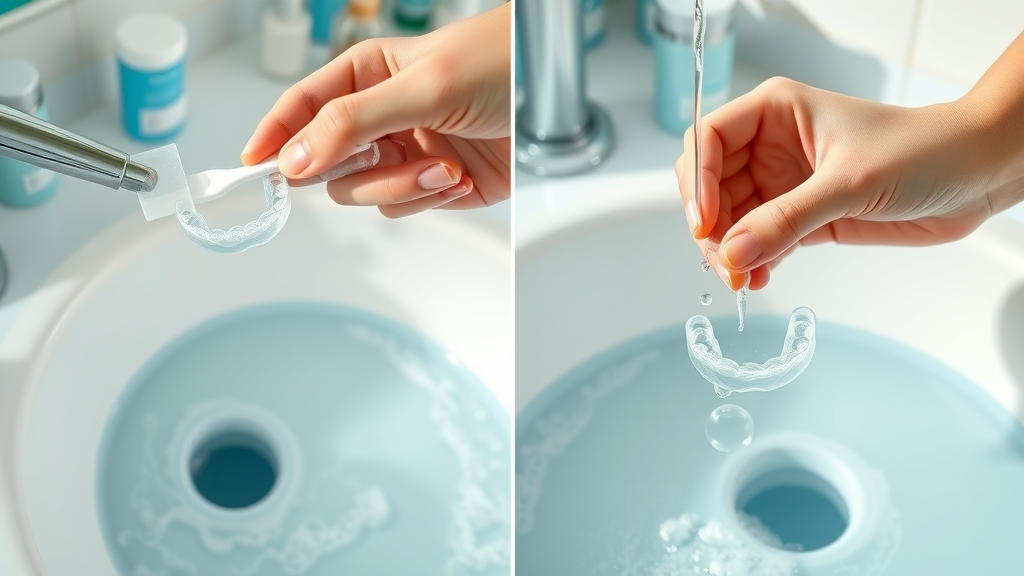
Keeping clear aligners clean is vital. Because they sit snugly over your teeth, any trapped bacteria or food can quickly lead to stains or bad odors—and could even damage your enamel. Cleaning your aligners is straightforward and can fit into your daily routine, making it an efficient choice for people always on the go.
Follow the steps below each time you eat and before you head to bed for optimal oral hygiene:
Clear Aligner Cleaning Instructions for Optimal Oral Hygiene
- Remove aligners before eating: Never eat or drink (except water) while wearing aligners to prevent distortion and staining.
- Rinse immediately: Hold aligners under lukewarm water to rinse off saliva, food bits, and bacteria as soon as you remove them.
- Gentle brushing technique: Use a soft-bristled toothbrush and mild, clear soap (never toothpaste, as it can scratch) to gently brush inside and out.
- Soaking tips for transparency and hygiene: Soak your aligners daily in a dedicated cleaning solution or crystals designed for clear aligners to keep them clear and fresh.
Step-by-Step: Cleaning Traditional Braces and Metal Braces
Cleaning traditional braces—whether metal braces or ceramic—takes a little more effort. Food and plaque easily trap around brackets and wires. Skipping steps might lead to stains, swollen gums, or even cavities, so learning the best techniques makes all the difference. Master these strategies and you’ll be on track for healthy, beautiful results at the end of your orthodontic treatment.
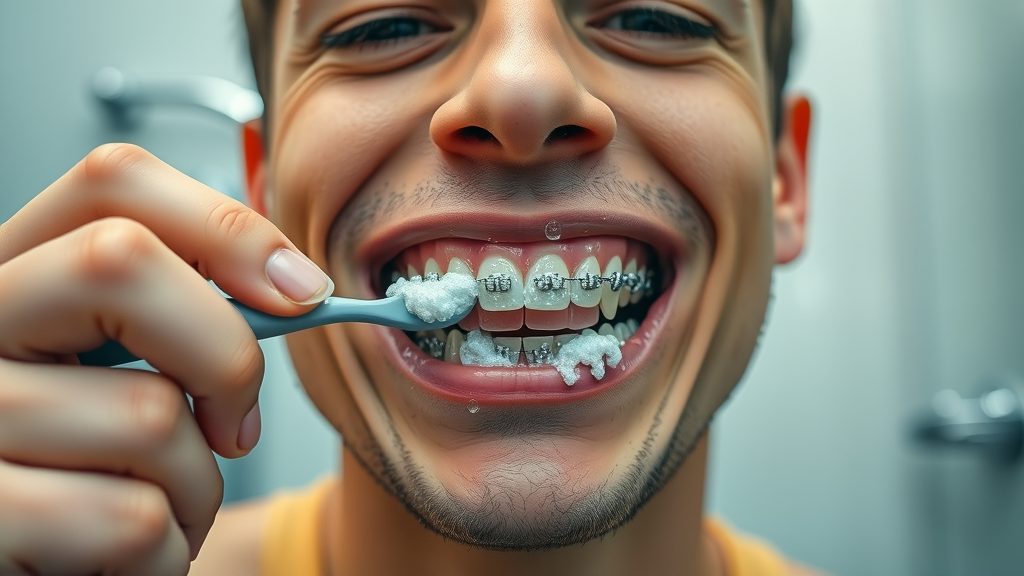
Brushing and Flossing Techniques for Braces
- Angle your brush: Brush at a 45-degree angle to reach under wires and around brackets for full cleaning.
- Threader flossing: Use a floss threader to loop floss between your teeth and under wires, removing plaque where brushes can’t reach.
- Waterflosser recommendations: Consider a waterflosser for a gentle, effective clean between teeth and around hardware.
- Frequency tips per treatment time: Brush and floss after every meal or snack—more often than with removable options.
Patience and consistency are key. If you rush or skip steps, stubborn plaque, and food particles can quickly lead to other issues, affecting your orthodontic treatment success.
Common Hygiene Challenges in Orthodontic Treatment
Whether you choose clear aligners or traditional braces, some hygiene hurdles are common. Braces create extra nooks and crannies, while aligners (if not cleaned regularly) can harbor bacteria and cause bad odors. Proactive care solves most of these issues before they require a trip to the dentist or orthodontist.
Troubleshooting: Stains, Odor, and Plaque Build-up With Clear Aligners or Traditional Braces
- Spotting trouble signs: Look out for persistent bad breath, white spots, or yellowing around brackets or aligners. These are signals that your cleaning isn’t reaching every spot.
- When to contact your orthodontist: If you see swollen gums, bleeding, or stubborn stains, don’t wait. Quick action can prevent bigger issues.
- Solutions for persistent issues: Professional cleanings, special pastes, or extra-strong mouthwash may be recommended if you’re struggling to keep up at home.
Treatment Time and Its Impact on Maintenance & Hygiene

How long you’ll need to keep up a strict oral hygiene routine depends on your treatment time. For mild to moderate cases, clear aligners might only be needed for 6-18 months, fitted in a series of custom trays. Metal braces, meanwhile, can be necessary from 18 months to over two years, especially for complex orthodontic issues. The longer your treatment lasts, the more consistent effort you’ll need—but every day of care earns you a healthier, more confident smile in the end.
How Treatment Duration Affects Daily Oral Hygiene Regimens
Shorter treatment times with clear aligners mean less time managing strict routines, but they require diligent cleaning for up to 22 hours a day. Longer, more complex cases—where braces are more common—demand even greater attention to brushing, flossing, and avoiding problem foods for the full treatment period. If your schedule is busy or you know longer efforts will be tricky, that can factor into your decision.
| Treatment Option | Average Duration | Maintenance Demand |
|---|---|---|
| Clear Aligners | 6–18 months (22 hours/day wear) | Remove, rinse, brush after all food/drink; soak daily; keep track of schedule |
| Traditional Braces | 18–36 months (fixed) | Careful brushing/flossing after each meal; avoid specific foods; more time per cleaning |
Choosing Between Braces and Aligners: What Suits Your Lifestyle and Oral Hygiene Needs?
Now that you’ve seen the facts, it’s all about what matches your day-to-day routine. Are you disciplined about oral care and changing aligners on schedule? Do you snack often throughout the day? Does your active lifestyle make removable trays impractical, or would you rather avoid wires altogether? Your preferences and habits can point you clearly toward aligners or braces. The right choice is the one you can maintain consistently.
Lifestyle Assessment: Are Clear Aligners Easier Than Braces for Maintenance & Hygiene?
- Activity level
- Eating habits
- Scheduling flexibility
- Commitment to daily care
Watch real patients talk about their daily cleaning routines, comparing the advantages and challenges of both clear aligners and traditional braces. From application and removal tips to honest before-and-after results, you’ll see exactly what goes into keeping your smile stunning with each option.
[Note: Video embed or link would appear here in a live article]
People Also Ask: Is Invisalign More Hygienic Than Braces?
Detailed Comparison: Oral Hygiene With Invisalign (Clear Aligners) and Traditional Braces
Many people want to know, “Is Invisalign more hygienic than braces?” The short answer: clear aligners like Invisalign can be easier to keep clean, primarily because they are removable. You can brush and floss normally, reaching all surfaces of your teeth and the aligners themselves. However, the hygienic advantage only works if you follow all steps closely—rinsing, brushing, and soaking the trays every day. Braces, being fixed, always leave nooks where food and plaque can hide, requiring more effort and special tools for proper cleaning.
That said, those who skip aligner cleaning can actually see more plaque and odors trapped next to teeth. So, true hygiene depends less on the system, more on your consistency.
People Also Ask: Are Aligners Easier Than Braces?
Convenience Factors: Ease of Cleaning Clear Aligners vs. Traditional Braces
Cleaning clear aligners is typically more straightforward because you can pop them out to brush and floss, as opposed to working around brackets and wires. There are no special tools required other than your tray case, toothbrush, and aligned cleaning solution. Still, aligners must be cleaned every time they’re removed—which is often if you eat or snack frequently. For people who prefer a quick, unobstructed brush and floss, aligners are generally considered easier to manage.
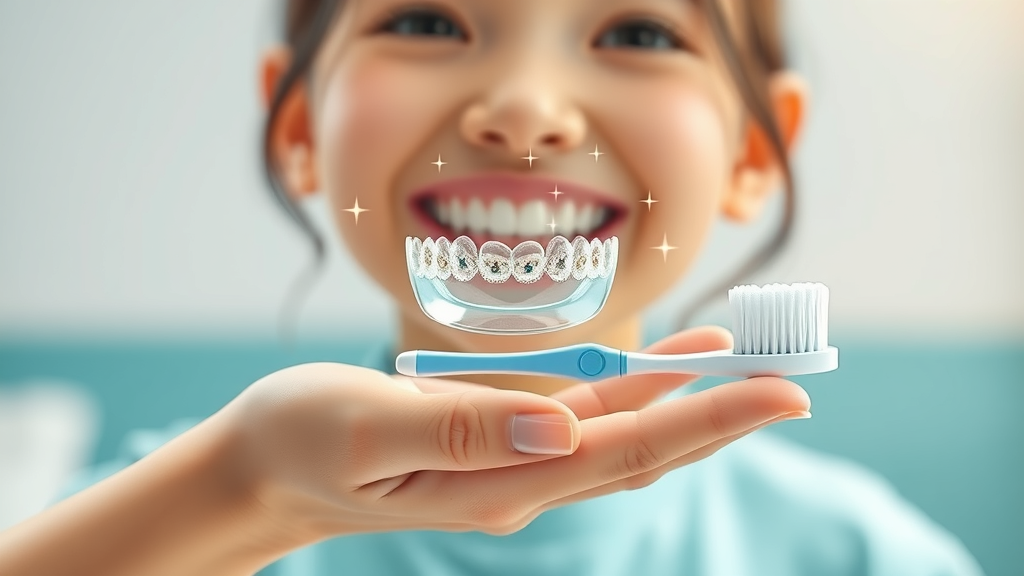
Meanwhile, braces require persistence for cleaning under wires, especially after snacks or sticky foods, making oral hygiene with traditional braces more time-consuming. For many, the flexibility of aligners is the winning factor for ease.
People Also Ask: Are Braces Less Maintenance Than Invisalign?
Evaluating Day-to-Day Maintenance & Hygiene Demands for Metal Braces, Clear Aligners, and Invisalign
From a strictly daily routine perspective, braces can sometimes feel less demanding—you don’t need to remember to remove, rinse, or store trays. But the cleaning itself takes longer and is often trickier. With aligners, the responsibility shifts to keeping up with daily soakings and proper usage, especially as aligners should be worn 20–22 hours per day. Forgetting to put aligners back in after a meal, for example, disrupts your treatment and could set you back.
The bottom line: clear aligners demand consistency with their own set of habits, while metal braces tie you to a slower but steady cleaning routine. Pick the approach you know you can keep up with.
People Also Ask: What Is the Downside of Aligners?
Potential Drawbacks: Clear Aligners and the Challenge of Consistent Hygiene

No system is perfect. The biggest downside for clear aligners? Consistency matters. If you forget to clean after snacks, quickly rinse trays, or fall behind on wear time, you can run into problems. Trays can become cloudy, odorous, or even harbor bacteria, leading to oral health complications. For people who snack frequently, attend events, or have very unstructured days, aligners can require a degree of vigilance that might be more challenging over time. On top of that, trays are prone to being lost or accidentally thrown away if not placed in a case after meals.
FAQs: Maintenance & Hygiene for Braces and Aligners
-
What foods should be avoided with braces or clear aligners?
With braces, skip sticky candies, nuts, hard fruits, popcorn, and gum—these can damage wires or brackets. With aligners, avoid eating or drinking (except water) while wearing trays, to prevent stains and distortion. -
How often should aligners be cleaned?
Clean your trays every morning and night—plus after every meal or snack. Rinse with water and use a clear aligner cleaning solution daily. -
What happens if you don’t maintain oral hygiene during orthodontic treatment?
Poor cleaning leads to white spots, cavities, gum disease, bad breath, and stains—sometimes causing permanent damage to your teeth and gums.
Conclusion: Maintenance & Hygiene — Weighing Clear Aligners Against Traditional Braces
"Your daily effort is the real key to a beautiful, healthy result, whether you choose clear aligners or traditional braces."

Subscribe and Join the Grand Strand Smile Spotlight Community!
- Your smile is worth it — and staying informed is the first step. Join hundreds of locals already following Grand Strand Smile Spotlight for updates, advice, and trusted care insights.
- Subscribe now to get the latest Grand Strand orthodontic guides, tips, and updates — right to your inbox. No spam. Just smiles.
- Want more expert-backed answers about braces, Invisalign, and local orthodontic care? Subscribe to Grand Strand Smile Spotlight and stay ahead of your smile journey.
When considering the ease of maintenance and hygiene between braces and clear aligners, it’s essential to understand the daily care routines each requires.
Braces:
-
Brushing: Requires brushing after every meal to remove food particles from brackets and wires. Special tools like interdental brushes are often necessary to clean hard-to-reach areas. (abarorthodontics.com)
-
Flossing: Flossing can be challenging due to the fixed nature of braces, often necessitating the use of floss threaders or water flossers to clean between teeth and under wires. (abarorthodontics.com)
-
Dietary Restrictions: Certain foods, such as hard candies, popcorn, and sticky treats, should be avoided as they can damage brackets and wires. (invisalign-toronto.ca)
Clear Aligners:
-
Brushing and Flossing: Since aligners are removable, you can maintain your regular oral hygiene routine without obstruction. It’s important to brush and floss after every meal before reinserting the aligners to prevent trapping food particles. (rivervieworthodontics.com)
-
Cleaning Aligners: Aligners should be cleaned daily using a soft toothbrush and clear, lukewarm water to prevent plaque buildup and maintain clarity. (abarorthodontics.com)
-
Dietary Freedom: Aligners should be removed before eating, allowing you to enjoy a wide variety of foods without restrictions. (oneilldentalcare.ie)
In summary, clear aligners generally offer a more straightforward maintenance routine due to their removability, allowing for easier brushing and flossing without the need for special tools. However, they require consistent care of both your teeth and the aligners themselves to ensure optimal oral health. Braces, while effective, demand more meticulous cleaning efforts and dietary adjustments to maintain hygiene.
 Add Row
Add Row  Add
Add 




Write A Comment